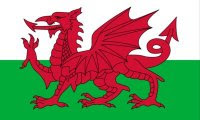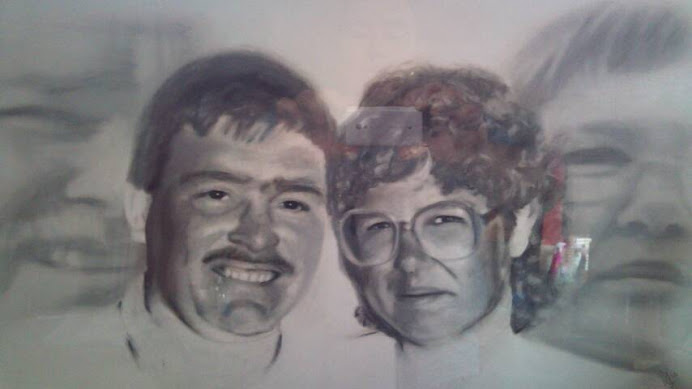We tend to think of using acrylic on wood, canvas and canvas board. However there are papers on the market for mixed media work and specifically for acrylic paints. The one that I am using today was a gift from the lovely people in the Art Shop on Pier Street Aberystwyth. It was being thrown out as damaged stock after being on display in the window, whereupon there was a water leak. Those who know me, know that after my make everything last childhood; I hate waste. Those of you who have seen some of my previous artwork on Social Media and or my Blog; may recall a 'Reindeer snow scene' mixed media painting. That piece was accomplished on a large sheet of paper that others had amongst other things managed to coffee stain and scribble on. There was no way that I would let that particular sheet be thrown out. It was just a case of having an idea for artwork using some of the shapes and shades that appeared amongst the mess.
So here we are with an A4 pad of Daler Rowney 'System 3' acrylic paper weighing in at 140 lbs as my support for todays painting. There are other papers on the market and indeed Daler Rowney do another pad that is somehow 25% cheaper, and around 33% heavier. So I shall have to pop into the Art Shop on Pay Day and snaffle up one of those pads as well.
I marked out a 9mm pencil boarder and then applied cheap masking tape to hold the paper down while wet. I prefer to use 'Artstat' by 'Creative House' Gumstrip sealing tape (circa £4.50 per roll to hold down my watercolour paper, but opted for masking tape for two reasons; (i) I'm trying to show you how to quickly paint an effective image with acrylics and using masking tape is far quicker than gumstrip, and (ii) it's acrylic and not watercolour. So even when applying the first coat of Winsor & Newton 'Galeria' Raw Sienna as a wash, the paper shouldn't bubble up as much as with a watercolour wash. I'm also relying on the fact that in my 'teach yourself' acrylic painting course; the base wash-coat will seal the paper and future wet or wet-on-wet layers won't seep through and further distort the support.
Using the important 'Rule of Thirds', I have placed my horizon line in pencil some 6cm up from the base of the painting area. Applying the base wash-coat in one go using a Daler Rowney 'System 3' No.12 Filbert brush, I have deliberately intensified the colour below the horizon line. All of that was allowed to dry while I typed up these notes so far. It is at this point that I add 'Prussian Blue' acrylic paint to my Pay-Day shopping list, as unfortunately today I only have Daler Rowney Ultramarine, Lefranc Louvre Deep Blue and a smidging of Boldmere Cerulean Blue to work with. So here goes:
With the base wash coat dry, I've mixed up Lefranc Louvre 'Deep Blue' with Lefranc Louvre 'Black'. Leaving some of both the black and the Deep Blue untouched on the palette. Some of this 'blue-black' mixture has been applied to the paper above the horizon line. A clean wet brush was used to apply water across the paper and later on to lift off some of the blue-black where I want the light to appear. It's not watercolur and it's all 'teach yourself', so for the next stage, I added some black onto the paper in the key darkening areas. Left alone with the black block, the sky just wouldn't look right, so still using the Filbert brush, I blended the colours with brush strokes and stippling.
The left handside of the painting has distinct brush movement marks to contrast with the right handside. Some interest needed to be introduced into the sky, as this is going to be quite a simple painting. Remember, the essence of the image is quick and effective. If you look carefully I have also introduced some downward strokes of black on the left of the sky close to the horizon. This will be the rain storm over part of the city. Now it's time to change the murky water, clean the brush yet again, and then start to work on the sea.
My intention now is to limit the palette to the three chosen colours; 'Galeria' Raw Sienna, and Louvre 'Deep Blue' and 'Black'.
With everything dry, and clean water in the pot, I ran a broad stroke of water just overlapping the horizon line using my Filbert brush. In fact I ran a second stroke across the first to ensure that the overlap was wet. Still using the 'Filbert' and my blue-black mixture; I introduced shapes along the horizon line to represent Venice in the distance. By wetting the surface first and overlapping the horizon line, these shapes merge into the sea and become hazy reflections. While the paint was wet, I used the cleaned brush to brush out both the left and right handside of the cityscape, in order to get those colours (and therefore the defined shapes) to fade away. To provide some further definition black paint was brushed into parts of the central area.
The sea was constructed by using the 'Filbert' and our blue-black mixture and then black to darken down some broad areas to the left and right of the image and to further darken towards the front. It was then time to change from the Filbert brush to a Daler Rowney 'System 3' 1 inch 'Script' brush in order to introduce some detail into the sea. We are looking to apply smaller strokes to the background and larger strokes to the foreground. All I'm using is the blue-black mixture, water, and occasionally some of the Raw Sienna. I'm just forming lines across the page using varying intensities if the paint mixtures. These strokes form the sea over the original Raw Sienna 'wash coat' that was applied to the paper at the beginning of this short demonstration.
You are either going to like or dislike the final image, but I hope that there is something in this explanation that will help you with your own artistic journey. Meanwhile I have to clean up these brushes and my makeshift palette as dinner is almost ready. Oh happy days.








